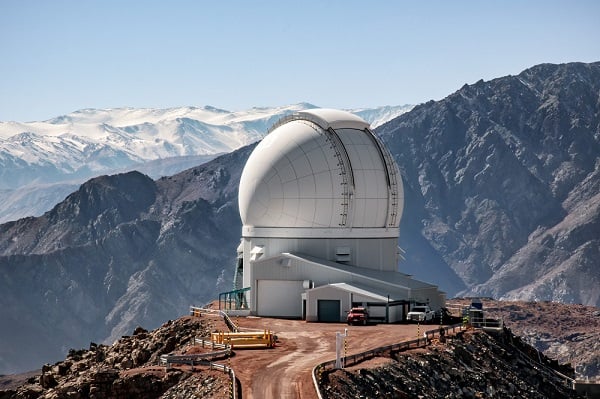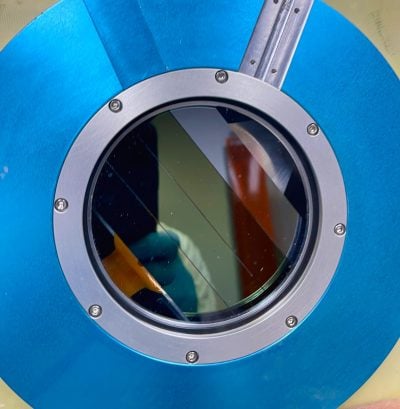Using an instrument on the 4.1-meter Southern Astrophysical Research Telescope, researchers obtained the first astronomical spectrum using skipper charge-coupled devices (CCDs). Originally envisioned for this purpose, the technology has been largely limited to the study of charged particles since its introduction in 1990.
CCDs are two-dimensional arrays of light-sensitive pixels that convert incoming photons into electrons. Conventional CCDs were the first image sensors used in digital cameras. While CMOS sensors have largely replaced them in the consumer camera world, CCDs remain a staple in many scientific imaging applications, like astronomy, for example. Their precision, however, is limited by electronic noise.
“If you have one electron in a pixel, sometimes you'll measure three electrons,” said Alex Drlica-Wagner, a cosmologist at the U.S. Department of Energy (DoE)’s Fermi National Accelerator Laboratory (FermiLab), who led the project. “Because of the noise, you can’t make a precise measurement.”

The SOAR Telescope on Cerro Pachon in Chile. Courtesy of NOIRLab.
Skipper CCDs were imagined as a way to address this. Instead of taking a measurement of that one electron just one time, a skipper CCD will measure it multiple times, taking an average of the randomized readout noise for a more precise measurement.
The method was anticipated to bring about much greater accuracy, but because of the technological limitations in both the readout electronics and in the detector fabrication process at the time, the improvements did not match up with the theoretical value.
“You ended up still being able to reduce the readout noise through this multiple measurement process, but you couldn't do it quite as well as the theoretical prediction,” Drlica-Wagner said.
In theory, measuring the charge four times would reduce the noise by a factor two. Measuring it 16 times would reduce noise by a factor of four. Sixty-four measurements for a factor of eight, and so on. The results were still an improvement, but the technique increased the readout time.
“And for astronomy, that's time that could be spent collecting more photons,” Drlica-Wagner said.
The skipper CCD was largely shelved until 2017, finding use in rare particle detection. Only very recently has it been used for astronomical observation.
A close collaboration between physicists, astronomers, and engineers at Fermilab, the University of Chicago, the National Science Foundation’s NOIRLab, Lawrence Berkeley National Laboratory, and the National Astrophysical Laboratory of Brazil sought to bring together incremental improvements driven by disparate research projects, commercial endeavors, and production advancements to bring the technology up to its initially predicted potential and beyond.

Four skipper CCDs mounted inside a cryogenic vacuum vessel in preparation for on-sky observations are shown. Courtesy of Edgar Marrufo Villalpando/AstroSkipper Collaboration.
The work is a culmination of improvements in CCDs that has enabled smaller structures on the detectors, higher production yield and consistency, improved readout electronics, advancements in the silicon used to produce the sensors, and improvements in packaging, among other factors.
“All of this allows us to now achieve the theoretical noise performance,” Drlica-Wagner said. The current measurement uncertainty stands at 0.039 electrons of noise.
On March 31 and April 9, researchers used skipper CCDs in the SOAR Integral Field Spectrograph to collect astronomical spectra from a galaxy cluster, two distant quasars, a galaxy with bright emission lines, and a star that is potentially associated with a dark matter-dominated ultra-faint galaxy.
“What’s incredible is that these photons traveled to our detectors from objects billions of light-years away, and we could measure each one individually,” said Fermilab researcher Marrufo Villalpando.
Although the project to improve skipper CCDs has yielded results worthy of use in astrophysical study, researchers are still working to push the technology forward. Drlica-Wagner noted efforts focused on adding multiple readout amplifier structures on a detector in order to provide faster results. The next generation of skipper CCDs, developed by Fermilab and Lawrence Berkeley National Laboratory, is 16 times faster than current devices.
These devices are poised for inclusion in upcoming cosmology projects from the DoE, such as the spectroscopic experiments DESI-II and Stage-5 Spectroscopic Survey. Another is NASA’s Habitable Worlds Observatory, which seeks to directly image and take spectra of exoplanets in the habitable zones of sun-like stars. “The rate at which photons would arrive is so low that you really need very low noise detectors to be able to measure them,” Drlica-Wagner said.